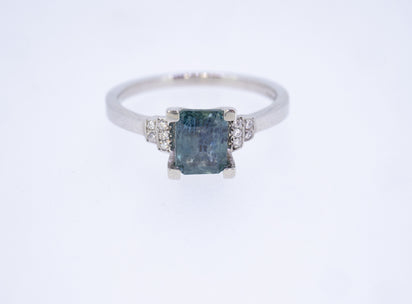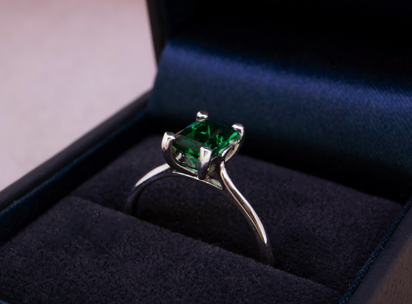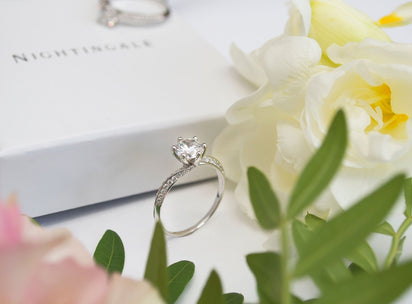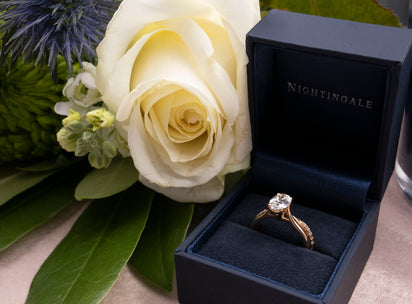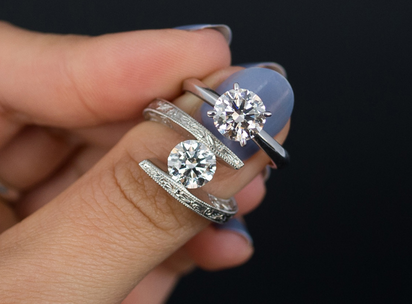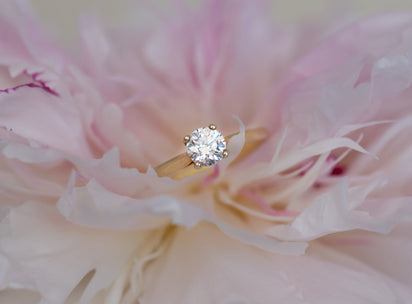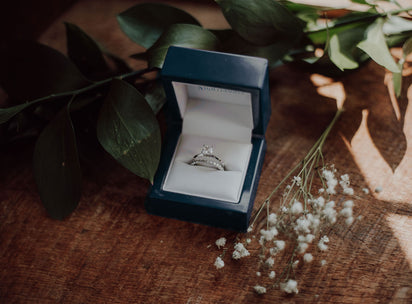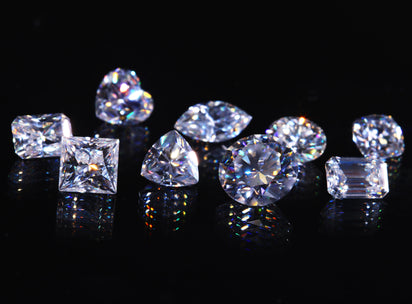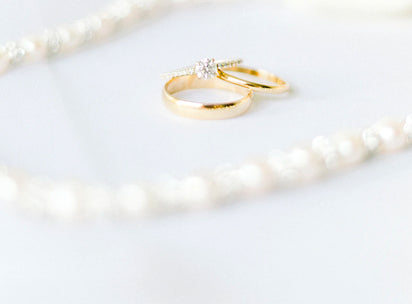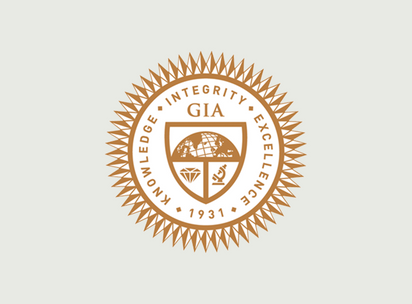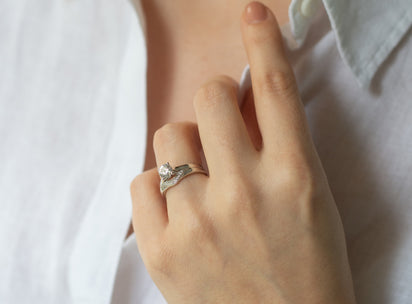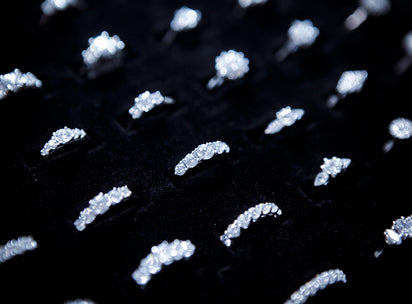The quick guide
Historically most of the world’s rubies come from Myanmar (formerly Burma) and more recently Mozambique, however if you’re looking for rubies with ethical origins you’ll find the best mines in Sri Lanka, Tanzania and Iceland.
Unfortunately there isn't a universal accreditation for ethical rubies so your best bet is working with a specialist jeweller with experience in ethical sourcing.
Lab grown rubies, which cost much less than mined, are also an excellent choice for the more ethical consumer if they have come from a lab with sustainable working practices.
Want more in depth information? We've got it below!
Rubies explained
Rubies are one of the ‘big 4 gemstones’ alongside diamonds, sapphires and emeralds. They’re very hard, measuring 9.0 on the Mohs hardness scale, with only diamond and moissanite rated higher.
Ruby is a variety of the mineral corundum, with their defining quality being their rich red colour. They get this quality because of a higher level of chromium being present when corundum is formed deep underground.
However, corundum can come in lots of different colours if chromium isn’t present, however these aren’t classified as rubies. Instead we call these sapphires!
It comes as a surprise to many that the only difference between sapphire and rubies is their colour, but they're both corundum with almost the exact same chemical makeup.
How to find an ethical ruby source
As with all gemstones, finding a truly ethical source can be challenging.
Coloured gemstones don’t typically get the same oversight as diamonds so there is no formal certification scheme like the Kimberley Process which you can rely on.
Instead you should find a seller that specialises in the ethical sourcing of rubies. Incidentally, that’s exactly what Nightingale does.
Where Nightingale sources ethical rubies
Our commitment to transparent and vetted supply chains means we typically source our rubies from Sri Lanka.
We like gemstones from Sri Lanka because the country has largely rejected large scale industrial mining, relying instead on traditional methods which allows more workers to earn a living in the gemstone trade.
Sri Lanka is fortunate to have most of their gemstones come from secondary sources such as river beds and flood plains which eliminates the need for heavy mining.
If you’re wondering how countless rubies ended up in such shallow ground then you’re not alone. Most people think gemstones can only be found deep underground, but with the right conditions gemstones can be pushed from underground deposits (commonly referred to as ‘primary deposits’) to the surface and then picked up by rivers and transported to new locations.
Over time they’ll become submerged again, but can be easily found with shallow pit digging.
We refer to these as secondary or alluvial deposits. And Sri Lanka is full of them.
Other ethical sources
Tanzania mines are also another great choice due to their protections around worker and environmental welfare. Their standards are much higher than other African nations so we can sometimes source rubies from here too.
Greenland should also get an honorary mention when talking about ethical ruby sourcing. The small country has recently started mining rubies and pink sapphires with ground breaking in 2017.
We love their approach to environmental and ethical standards, but given how remote the mines are they’re having trouble extracting rubies on a large scale.
Also, most of their rubies aren’t suitable for faceted cuts typically used in engagement rings. It’s much more common for Greenland rubies to cut in a cabochon (smooth rounded) style which we typically don't use in our ethical engagement rings.
Sources to avoid
Unfortunately rubies of questionable origin are sold on every high street in the country. So whilst it’s good to know where to find ethical rubies it’s just as important to know the places to avoid.
Myanmar (formerly Burma) used to the world’s premier source of rubies but various trade embargos and boycotts due to ethical issues have diminished their prominence in the market.
Mozambique in Africa filled this vacuum after discovering massive reserves in 2009, however various reports cite human right issues in the region. A single region known as Montepuez in the north is said to hold around 40% of the world’s supply so the likelihood of coming across these gemstones is high.
We always recommend you ask your jeweller of choice where they source their rubies. Most won’t be able to give you a specific answer and will just fall back on saying “they’re sustainable”.
We’d recommend you choose someone else if you hear that!
Lab grown rubies
If you’d prefer to source a ruby that hasn’t been mined from the earth then lab grown rubies are the best choice. Just like lab diamonds, lab grown rubies are chemically identical to mined rubies but have the following benefits:
- There won’t be an environmental impact, provided your ruby comes from a sustainable certified lab like the one’s Nightingale uses.
- Rubies are grown in labs by skilled workers with much higher protections and welfare standards than those found in most mines.
- The ruby you get will have a flawless clarity, which is almost impossible to find in mined rubies.
- You’ll be able to get a much better ruby for your budget, with high quality lab grown rubies costing much less
At Nightingale we’re able to set any of our ethical engagement rings with a lab grown ruby, just get in touch and ask!
How to identify a high quality ruby
Rubies can be one of the most expensive coloured stones per carat under the right circumstances.
As with other gemstones we judge their quality on 4 criteria:
As you’d expect, colour is the most important factor for ruby quality. Following a distant second is clarity. We’ll look into those two in a little more detail below, but a quick note on carat and cut before that.
As with other gemstones, the price you pay increases exponentially as carat size increases because high quality rough ruby gets much rarer at larger sizes.
Rubies can be found cut into all the usual styles including round, oval, cushion and pear. You’ll generally find cushion and oval cuts to be the most common.
Colour grades
The most revered rubies have either a vibrant or deep red hue. There’s a ‘goldilocks’ shade of red which is neither too bright nor too dark. A ruby that’s too light will look more pink than red, whilst one too dark will diminish how bright the stone looks to the naked eye.
Sometimes a rubies colour will be so light it will be classed as a pink sapphire instead. The exact cut off can vary depending on who’s doing the classification, but pink sapphires cost significantly less than a ruby which is good news if you prefer the lighter aesthetic.

The left gemstone is classed as a pink sapphire, whilst the one on the right is red enough to be classed as a ruby.
Clarity
Rubies will almost always have some degree of inclusions (marks within the gemstone) due to their relative softness compared to diamonds. In fact, if a ruby doesn’t have any it’s a fairly good guarantee it’s a lab grown gemstone.
The more visible inclusions present, the lower a ruby will be valued. Inclusions which are visible just below the table of the gemstone (the flat ‘top’ when viewed from above) will greatly reduce the desirability and value, so pay particular attention to that.
As always, finding the right gemstone is a matter of persistence and expertise, so team up with a good jeweller to make the entire process easier!
Ethical ruby engagement rings - 5 buying tips
The notion that all engagement rings have to be diamond is a little bit of an outdated idea. Rubies are a perfect choice given their associations with love, passion and good fortune.
However there are some things you’ll want to keep in mind, especially if you want an ethical engagement ring featuring a ruby!
Here’s our top 5 buying tips:
#1 - Consider durability in your decision
We mentioned earlier that corundum (that makes up rubies and sapphires) is the second hardest of the ‘big 4’ gemstones after diamonds. However, despite this high ranking on the Mohs scale they are still over 100 times softer than a diamond.
That means a ruby engagement ring will have a higher likelihood of being damaged by chipping or everyday wear and tear.
For most wearers this won’t be an issue, but if you have a particularly hands-on job/ lifestyle you may want to avoid pointed cuts such as marquise (which are more prone to damage).
Another option is to choose a more flush, bevelled mount which will offer the gemstone more protection.
#2 - Always verify the ethical origins of your ruby
If you’re visiting Nightingale it’s likely that ethical credentials are important to you. That’s why we’re making special mention to verifying the source of your ruby as ethical.
When Mozambeque found their vast ruby reserves they falsely labelled themselves as an ethical supplier when they clearly weren’t. This isn’t uncommon when dealing with rubies so ask your jeweller to clarify where your ruby came from and what assurances they can offer you.
#3 - Avoid imitations
There’s lots of imitation rubies available to buy, but very few of them are suitable for engagement rings.
Firstly, let’s talk about garnet. Garnet is a beautiful red gemstone with an intense colour and high clarity.
It’s very common to confuse the two stones due to their similar characteristics but garnets are significantly softer than rubies (measuring 6.5 on the Mohs scale vs 9 for rubies).
If you’re wearing one every day in an engagement ring the likelihood of damage and chipping is much higher which is why we don’t recommend them.
Spinel is another gemstone which commonly gets confused with ruby. In fact, the famous Black Prince Ruby which sits in the Imperial State Crown is actually a spinel. It wasn't until 1783 that we could actually distinguish the two gemstones apart.
Spinel, whilst beautiful in it’s own right suffers the same issue as garnets, they’re simply not as durable. Spinel measures a 7.5 on the Mohs scale, which is roughly half as hard as a ruby.
It’s important to note here that lab grown rubies have exactly the same qualities as their mined equivalent, so they’re just as hard and a great alternative to mined rubies.
#4 - Don’t be put off by inclusions
A common pitfall buyers fall into is comparing diamond clarity to ruby clarity like for like. This is a mistake because diamonds will always have a higher degree of clarity because they’re much harder to scratch than rubies.
A ruby with some visible markings doesn’t make it an inferior gemstone. And you’ll be hard pressed to find a visibly flawless ruby within a reasonable budget unless you opt for a lab grown.
#5 - Remember the other ethical considerations
Finding an ethically sourced gemstone is only one element of buying an ethical engagement ring. You should check where the metal in your ring mount has been sourced from and the manufacturing process involved too.
Look for recycled metals as a minimum and consider other schemes such as Fairtrade and Fairmined metals.
Need some help?
As you can see, there’s a lot that goes into finding an ethical ruby! If you’d like us to help pick out a stone that meets your standards then get in touch and we’ll do all the sourcing for you.
We’ll even create an entire bespoke engagement ring with unbeatable ethical credentials!
